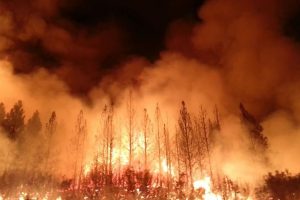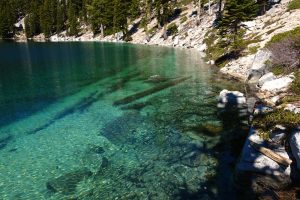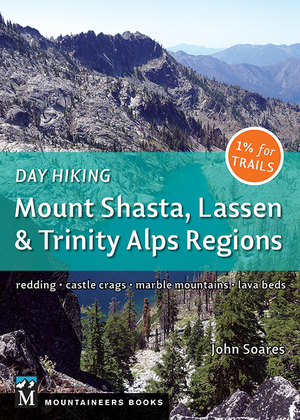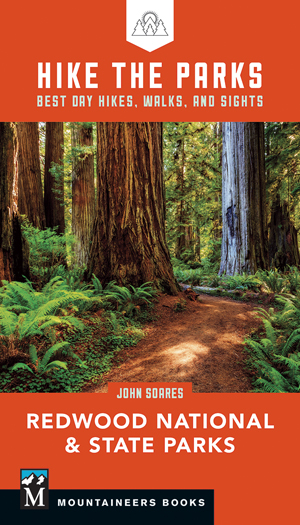
Surviving a wildfire you encounter while day hiking or backpacking is definitely possible. This post gives key wildfire-survival hiker safety tips to decrease the chance you’ll be caught in a wildfire — and to increase your chance of survival if you do.
I am an avid hiker and also a hiking guidebook writer, and I hike in and write about Northern California, a very popular hiking spot where wildfires are increasing in severity. As I write this, fires burn across California, and the Carr Fire is burning large parts of my hometown of Redding, California. This post is my way of doing what I can to help, since a significant number of people read this blog.
Before You Go Hiking: Assess the Wildfire Danger
Pay attention to the news and social media like Facebook, check websites about wildfires and smoke conditions, and especially check the website of agencies that combat wildfires and give updates on wildfire growth and evacuation areas. (I have a post on California fire, smoke, and air quality conditions that also has links applicable to other states.)
Ranger stations are often your best source of current information.
Check the Weather for Thunderstorms, Lightning, and Red Flag Warnings
Also check the weather forecast for the area where you intend to hike. Lightning from thunderstorms is a common cause of backcountry wildfires; weather reports provide detailed discussion of location, probability, and severity of thunderstorms. Weather forecasts also predict wind, humidity, and temperature conditions, and they include red flag warnings about impending fire danger.
Currently, my favorite source for weather is the National Weather Service.
And make sure you follow all rules and regulations about campfires for your state. You don’t want to be the cause of a major conflagration.
Plan Escape Routes from Wildfires
Before you take your day hike or backpacking trip, look at topographic maps and read descriptions of your trail and nearby trails to determine the best escape routes if a fire does threaten. Plan for different fire locations and directions of movement. Try to have at least two routes out no matter where you are.
Noticing a Wildfire While Hiking or Backpacking
If you see smoke, assess its distance from you, the direction of smoke movement, and the smoke quantity. This helps you assess the potential danger.
It’s always better to be safe than sorry. If you feel there is any potential danger, hurry back to the trailhead and get out of there. If necessary, leave gear behind.
When it’s safe to do so, call 911, the managing government agency, or the county sheriff’s office to report the fire, especially if it’s a small one that may have avoided previous detection.
Camp for Free in California National Forests
 California’s national forests and BLM lands have thousands of miles of dirt roads with lots of spots for dispersed camping (boondocking). My book provides all the info you need to get started (but is not a guide to specific sites):
California’s national forests and BLM lands have thousands of miles of dirt roads with lots of spots for dispersed camping (boondocking). My book provides all the info you need to get started (but is not a guide to specific sites):
- Researching the best locations
- Finding the best camping spots
- Backcountry safety and ethics
- What to take
Buy it on Amazon
Buy it on Apple, Kobo, and Nook
Surviving a Wildfire When Hiking
Wildfires can move unpredictably and rapidly. Don’t assume you can outrun or out-walk a fire, as they can have explosive growth, especially during the afternoon hours when temperatures are highest and humidity is lowest.

Take Action Before the Wildfire Reaches You
Ridges and forests are the most dangerous. Fire can rise rapidly uphill, and it can roar rapidly through a forest. Move away from the fire and to lower area out of the forest that will give you the highest probability of surviving.
You may be able to move out of the path of the fire to a safe area, depending on the rate and direction of fire movement.
Sheltering in Place during a Wildfire
Find a depression in a meadow or open area with the least amount of flammable materials. If there’s time, clear as much flammable material away from your chosen spot in as wide a circumference as possible. If feasible, dig a small hole in the dirt for your face.
Another good spot: amidst large rocks that can block heat and flames.
If you can reach an area that has already burned, stay there. A stream or lake can be an excellent place to shelter, but avoid streamside or lakeside vegetation.
If there’s time, remove synthetic clothes, since these can burn at lower temperatures than natural fibers. Wear a jacket and any other natural-fiber clothes to help protect you from heat and flames.
It’s also very important to protect your lungs. Place a cloth or piece of clothing over your mouth to protect your lungs from both heat and smoke particles.

What To Do As the Wildfire Passes Over You
Stay as calm as possible, and do your best to calm any hiking companions. Lie face down with your feet pointed toward the flames. Stay there until the flames have passed. Do not give in to any temptation to jump up and run: the air 5 feet above the ground is far hotter and smokier and can quickly kill you. The flames will roar loudly and can last up to a minute. Do not stand up until just after the flames have passed.
What To Do After the Wildfire Has Passed
Plan an escape route that keeps you away from the path of the fire and on or near previously burned areas, if possible, since changing winds can cause the fire to reverse direction and move back in the direction it previously burned. Pay close attention to hot areas, spitting embers, and burned tree snags that can fall or drop branches.
Your Take
Thoughts? Suggestions? Experiences? Share in the comments below.











Sometimes I’ll make a Google Earth screen print of the area I plan to visit, and take it with me, for things like escaping a fire.
That’s a good idea, Derral. I also frequently print out a Caltopo map of my hiking area, and I usually have the larger USFS wilderness map with me, Trinity Alps Wilderness, for example.
You did not say anything about setting a fire in front of you in the direction of the wind to clear a burn spot in advance!
Jeff, you’re right I didn’t, but I did consider it. I know that’s an option for professional firefighters who have training, but I’m focused on hikers who don’t have training.
As an ex wildland fire fighter who survived a burn-over situation, starting a back fire without having any sort of training can turn deadly. The wind can shift in a second. Fire creates it’s own wind. Your best bet is to get into a meadow, a clearing, middle of a river, etc. and plan an escape route. While hiking, I always take the time to stop look behind me as well as in front of me to be completely aware of my surroundings. If you feel you are in immediate danger, get into an open area and activate your SOS. This at least lets fire and search and rescue know there are hikers in the area of the active fire.
This is good. I was caught in a sagebrush Wilderness Study Area in a trailers large park of grass when out of nowhere enveloped in canopy of smoke. It was dense and felt close. I immediately pivoted toward a low bare cliff band I just passed. When I scrambled up a slot in the rock, I stumbled on a Native hunting pit. I rolled into it. Just as suddenly the smoke had come in, it shifted, then cleared. When I cam out two days later, there were no reports of any local range fires??
Does it help to wet the cloth you put over your nose and mouth?
From my personal experience as a wildland fire fighter I found that wetting my bandana made things worst as soot, dust and ash muddied up my bandana and made it harder to breath.
Does the wildlife tend to know where to go in a fire? Could we follow their lead?
Personally, I plan to adhere to the recommendations in the post above, and hopefully the animals are also getting off ridges and out of forest and heading for open areas and also meadows, rivers, and lakes.
Thank You !
Great info. Thank you!
Hi!
I actually did escape a wildfire and it was terrifying. I was able to hike out after talking to the Sherrifs via my Garmin In reach. I have included my story below. Thanks for writing this.
https://www.goldenstateofminds.com/blog-1/2018/7/13/my-personal-story-on-activating-the-sos-function-on-my-garmin-inreach
Wow. Thanks for writing your experience in such detail!
Call me crazy, but I am going to start carrying a half face < 2.5 pm respirator during the fire season because particles in smoke can get deep into your lungs and if you are out there for even a couple days that could be bad.. My respirator weighs only 5 oz. I guess you do whatever you can to increase you chances of survival becuase doing nothing is not a good option, Lot of vegegation on the windward side of the Cascade and in Olympic National Park, so unless I can get real lucky and find a cleared area, or get up against some rocks which you suggest, or have a fire blanket or whatever else the pros use, if you are laying down on the ground or even in a trench, near NW vegation, I would think that survival could not be expected. I think heading for a lake, if you can get there timely, would be my best bet for survival. maybe? As an aside, I was backpacking in the Sierras right near a wildfire once, being fought with flame retardment and helicoptor-scooped buckets from a lake. I was very concerned until a ranger said fire wasn't coming our way. But how the heck would I be able to make such a determation myself? I am always looking to improve my strategy including being told I am flat out wrong. What do you think?
Joe, I’m with you. I’d rather be over-prepared than under-prepared. I have an N-95 mask that’s in its own little plastic protector so it won’t get crushed in my pack.
I couldn’t help thinking – if the fire doesn’t get you, a rattlesnake might – when you wrote to hide in the rocks. I’m glad I live in a part of the PNW that doesn’t have rattlesnakes. What type of little shovel do you recommend for taking on hikes for clearing an area and digging in, just in case you have to let a fire burn over you? My dad had to do that about 50 years ago when on a fire line. Wow, he was so dirty and exhausted when he got home!! Very spooky!!